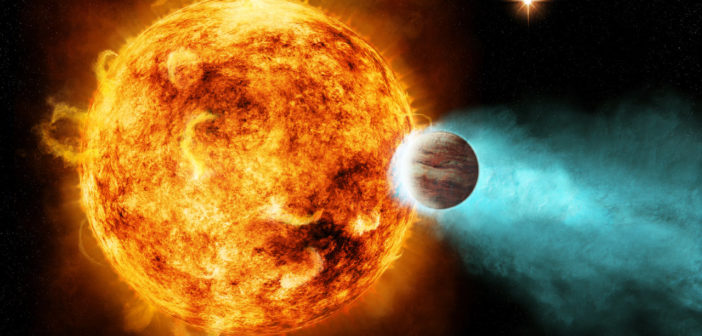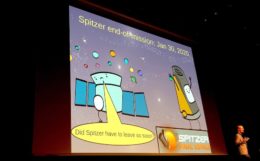Editor’s note: This week we’re in Reykjavik, Iceland at the Extreme Solar Systems (ExSS) IV meeting. Follow along to catch some of the latest news from the field of exoplanet research!
Session 10: Atmospheres I
How much do exoplanet scientists care about planet atmospheres? So much that, this morning, we kicked off with the first of three sessions on atmospheres. Welcome to Day 4 of ExSS!
To prepare to interpret images of distant, rocky worlds, we can start by observing nearby worlds — Jupiter’s Galilean moons — as though they were exoplanets. Laura Mayorga (Harvard-Smithsonian CfA) presented lessons learned from analyzing more than 5,000 images of the Galilean moons taken by the Cassini probe, exploring how properties like the angle of the Sun’s illumination affect our interpretation of observations.
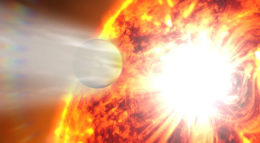
Artist’s impression of a star’s high-energy radiation evaporating the atmosphere of its planet. [NASA’s Goddard SFC]
We’ve discovered a wealth of worlds that fall between Earth and Neptune in size — but these planets can be ice giants, water worlds, or even primarily rocky. Björn Benneke (Montreal) demonstrated that we may be able to use observations of sub-Neptune atmospheres to help characterize the planets: atmospheric metallicity can tell us about how the planet formed and subsequently accreted solids.
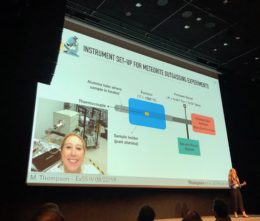
Maggie Thompson’s presentation came with a requisite selfie with her lab experiment setup! [AAS Nova/Maggie Thompson]
Time for the perennial question: But what about magnetic fields? Though it’s believed that magnetic fields should have a significant impact on planet atmospheres, we’ve struggled to obtain observations to confirm this. Wilson Cauley (UC Boulder) reported on the derivation of the magnetic fields of a small sample of hot Jupiters using observations of the interactions between these giants and their host stars.
The “radius valley” describes a dearth of small, short-period planets discovered with radii between roughly 1.5 and 2 Earth radii — a result that could be explained by photoevaporation of planet atmospheres. Leslie Rogers (U Chicago) presented theoretical calculations that suggests that planets that lie near the upper edge of this valley may become enhanced in helium and heavier elements after several billion years of hydrogen mass loss due to atmospheric escape.
Session 11: Population Statistics and Mass-Radius Relations
As of 21 August 2019, we’ve observed 4,043 confirmed exoplanets — with many more still in the pipeline. What can we learn from the broader statistics of observed exoplanet populations? Today’s late-morning session walks us through a few lessons.

The distribution of masses vs. locations for giant planets on long-period orbits, according to Benjamin Fulton’s work. Click to enlarge. [AAS Nova/Benjamin Fulton]
At this point, there are around 60 planets for which we have not only radius measurements, but also well-measured masses. Dave Latham (Harvard-Smithsonian CfA) provided a summary of what we’ve learned exploring the relation between these planets’ masses and radii — including evidence that most planets smaller than about 1.8 Earth radii are similar to our solar system’s terrestrial planets in their bulk densities.
Remember TRAPPIST-1? This system was discovered in 2017 and immediately made headlines for its seven temperate, terrestrial planets, many of which lie in the star’s habitable zone. Since this sole discovery, however, the TRAPPIST telescope hasn’t made any further transiting-planet detections. Was TRAPPIST-1 just dumb luck? Didier Queloz (Cambridge) argued TRAPPIST’s subsequent non-detections allow us to make inferences about the likely occurrence rate of planets like TRAPPIST-1b.
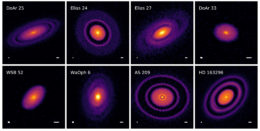
A small subset of the DSHARP protoplanetary disks, showing a variety of gaps and rings possibly generated by planets. [DSHARP]
Do we see any interesting patterns in Kepler populations with four or more transiting planets? The final three talks of this session beautifully illustrated the process of scientific debate, as Lauren Weiss (Hawaii), Wei Zhu (CITA), and Yanqin Wu (Toronto) all presented their differing answers to this question.
- Weiss put forward a “peas in a pod” picture: her data analysis from the California Kepler Survey suggests that planets in the same multi-planet system often have similar sizes and regular spacing. She argued that this pattern is astrophysical — it’s a remnant of planet formation.
- Zhu, on the other hand, argued that the “peas in a pod” pattern isn’t real, but is instead the result of observational biases. According to Zhu, Kepler’s signal-to-noise threshold influences which planets are detectable in each system; accounting for these biases would remove the apparent uniformity within Kepler systems.
- Wu took what perhaps is an even more radical stance: she argued that there’s a universal scaling law relating Kepler’s planet masses to their host-star masses — i.e., more-massive planets are found around more-massive stars. According to Wu’s analysis, the typical ratio of planet mass to stellar mass is ~8x the Earth-to-Sun mass ratio.
So who won the debate? Alas, that’s not how science works! Only further observational and theoretical evidence will settle whether Kepler multi-planetary systems truly show uniformity or not.
Session 12: Planets in and Around Binaries
This afternoon’s first session focused on a popular favorite topic: the existence of Tatooine-like planets orbiting within and around binary star systems.

Artist’s illustration of a circumbinary system: multiple planets orbiting two stars. [NASA Ames/JPL-Caltech/T. Pyle]
To draw useful conclusions from the 11 circumbinary planets Kepler has discovered, we first have to understand the underlying distribution of mutual inclinations — the inclinations between the planet orbit and the binary orbit. Ian Czekala (UC Berkeley) analyzed a sample of circumbinary protoplanetary disks to infer that disks around short-period binaries (P < 40 days) typically have low mutual inclinations, and disks around longer period binaries have a broad range of mutual inclinations.
Eleven Tatooine-like planets may not sound like a large sample, but we have prospects for more! Bill Welsh (San Diego State) presented on three more unconfirmed candidates: two from Kepler (KOI-3152 and KIC 10753734) and one from TESS (TIC 260128333). TESS is predicted to discover around a hundred more of these circumbinary planets over the course of its mission.
Session 13: Planets Around White Dwarfs
Next we switched gears to talk about another type of unusual host for exoplanets: white dwarfs. Since Sun-like stars should end their lives as white dwarfs, and they should retain their planetary systems in the process, we expect to find planets around white dwarfs. Have we?
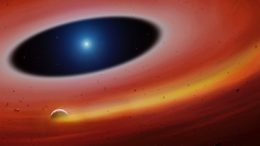
Artist’s impression of a solitary planetismal orbiting in a debris disk surrounding a white dwarf. [University of Warwick/Mark Garlick]
In addition to this direct evidence, we also have indirect evidence. Matthias Schreiber (U Valparaiso) described observations of a white dwarf that appears to be accreting a disk of hydrogen, oxygen, and sulfur. The composition is unusual for a disk around a white dwarf — but it perfectly matches the composition we expect for the deeper layers of a giant planet’s atmosphere. Schreiber argues that the gas of this disk has come from the evaporated atmosphere of an undetected giant planet orbiting the dwarf.
It turns out that about 30–50% of white dwarfs show heavy elements in their atmospheres, likely indicating that they have been polluted by accretion of planetary material. Amy Steele (U Maryland) presented her work modeling the chemical abundances of the circumstellar gas around these white dwarfs, which will help us to better understand observations.

Artist’s illustration shows a giant cloud of hydrogen streaming off a warm, Neptune-sized planet. [NASA, ESA and D. Player (STScI)]
Session 14: Atmospheres II
For the last session of the day, we returned for another look at planetary atmospheres.
Vincent Bourrier (U Geneva) opened the session with a comparison of GJ 3470b — a nearby warm Neptune shown by Hubble to be exhibiting dramatic atmospheric loss as it orbits close to its host star — to other evaporating warm Neptunes. GJ 3470b may already have lost 40% of its mass in its short, two-billion-year lifetime! Bourrier’s observations shed further light on the apparent dearth of Neptunes on short, close-in orbits.
Ian Crossfield (MIT) described what we’ve learned from Spitzer photometric follow-up of TESS planets, obtaining infrared transits and eclipses. A main takeaway: two planets can have exactly the same irradiation and gravity, but completely different atmospheres. Crossfield also tugged at our heartstrings by pointing out we’ll soon no longer be able no longer be able to make observations like this — Spitzer will be decommissioned in January 2020.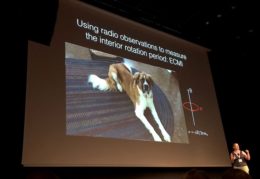
Katelyn Allers gets major bonus points for using a video of her dog to illustrate how synchrotron radiation works. [AAS Nova/Katelyn Allers]
Enric Palle (Canarias) described a He I survey, conducted with the CARMENES spectrograph, that’s exploring ultra-hot Jupiter- to Neptune-sized planet atmospheres via transmission spectroscopy. The goal of the survey is to build a large and diverse sample with high-resolution observations that can be used to understand atmospheric evolution.
Did you know that there’s a secret mode on the Hubble Telescope? Nikole Lewis (Cornell) introduced us to a useful — yet underused, due to some challenges — instrument on Hubble: its WFC3/UVIS G280 grism. With some new data reduction and analysis techniques, this grating prism can be used to obtain highly sensitive near-ultraviolet spectroscopic observations. By using this newly unlocked mode, Lewis and collaborators probed the chemical processes in hot Jupiter HAT-P-41b’s atmosphere.
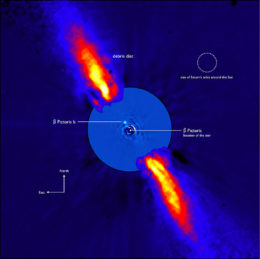
Infrared observation of the Beta Pic system, revealing the star, its surrounding dust disk, and the giant planet Beta Pic b. [ESO/A.-M. Lagrange et al.]
How did the giant planet beta Pictoris b form? Mathias Nowak (Obs. Paris) presented the first long-baseline interferometric observations of Beta Pic b, which allow us to probe the carbon/oxygen ratio in the planet’s atmosphere. The low C/O ratio found can be used to constrain the possible formation mechanisms for the planet.

